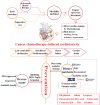Can Dietary Nutrients Prevent Cancer Chemotherapy-Induced Cardiotoxicity? An Evidence Mapping of Human Studies and Animal Models
- PMID: 35845064
- PMCID: PMC9277029
- DOI: 10.3389/fcvm.2022.921609
Can Dietary Nutrients Prevent Cancer Chemotherapy-Induced Cardiotoxicity? An Evidence Mapping of Human Studies and Animal Models
Abstract
Introduction: Chemotherapy has significantly improved cancer survival rates at the cost of irreversible and frequent cardiovascular toxicity. As the main dose-dependent adverse effect, cardiotoxic effects not only limit the usage of chemotherapeutic agents, but also cause the high risk of severe poor prognoses for cancer survivors. Therefore, it is of great significance to seek more effective cardioprotective strategies. Some nutrients have been reported to diminish cardiac oxidative damage associated with chemotherapy. However, the currently available evidence is unclear, which requires a rigorous summary. As such, we conducted a systematic review of all available evidence and demonstrated whether nutrients derived from food could prevent cardiotoxicity caused by chemotherapy.
Methods: We searched Medline (via PubMed), Embase and the Cochrane Library from inception to Nov 9, 2021 to identify studies reporting dietary nutrients against cancer chemotherapy-related cardiotoxicity. We performed descriptive summaries on the included studies, and used forest plots to demonstrate the effects of various dietary nutrients.
Results: Fifty-seven eligible studies were identified, involving 53 animal studies carried on rats or mice and four human studies in cancer patients. Seven types of dietary nutrients were recognized including polyphenols (mainly extracted from grapes, grape seeds, and tea), allicin (mainly extracted form garlic), lycopene (mainly extracted from tomatoes), polyunsaturated fatty acids, amino acids (mainly referring to glutamine), coenzyme Q10, and trace elements (mainly referring to zinc and selenium). Dietary nutrients ameliorated left ventricular dysfunctions and myocardial oxidative stress at varying degrees, which were caused by chemotherapy. The overall risk of bias of included studies was at moderate to high risk.
Conclusion: The results indicated that dietary nutrients might be a potential strategy to protect cardiovascular system exposed to the chemotherapeutic agents, but more human studies are urged in this field.Systematic Review Registration: https://inplasy.com/inplasy-2022-3-0015/.
Keywords: cardiotoxicity; chemotherapy; diet therapy; heart diseases; oral nutrition; systematic review.
Copyright © 2022 Zhang, Yang, Li, Zhao, Jiang, Wang and Liu.
Conflict of interest statement
The authors declare that the research was conducted in the absence of any commercial or financial relationships that could be construed as a potential conflict of interest.
Figures




Similar articles
-
Dietary glycation compounds - implications for human health.Crit Rev Toxicol. 2024 Sep;54(8):485-617. doi: 10.1080/10408444.2024.2362985. Epub 2024 Aug 16. Crit Rev Toxicol. 2024. PMID: 39150724
-
Nutrition Modulation of Cardiotoxicity and Anticancer Efficacy Related to Doxorubicin Chemotherapy by Glutamine and ω-3 Polyunsaturated Fatty Acids.JPEN J Parenter Enteral Nutr. 2016 Jan;40(1):52-66. doi: 10.1177/0148607115581838. Epub 2015 Apr 17. JPEN J Parenter Enteral Nutr. 2016. PMID: 25888676 Free PMC article.
-
Potential usefulness of diastolic parameters measured by strain imaging echocardiography in the early prediction of chemotherapy-induced cardiotoxicity.Med Hypotheses. 2017 Apr;101:30-32. doi: 10.1016/j.mehy.2017.02.004. Epub 2017 Feb 10. Med Hypotheses. 2017. PMID: 28351486 Free PMC article.
-
Identification of cardiotoxicity related to non-small cell lung cancer (NSCLC) treatments: A systematic review.Front Pharmacol. 2023 Jun 13;14:1137983. doi: 10.3389/fphar.2023.1137983. eCollection 2023. Front Pharmacol. 2023. PMID: 37383708 Free PMC article.
-
Nutritional interventions for preventing stunting in children (birth to 59 months) living in urban slums in low- and middle-income countries (LMIC).Cochrane Database Syst Rev. 2019 Jun 17;6(6):CD011695. doi: 10.1002/14651858.CD011695.pub2. Cochrane Database Syst Rev. 2019. PMID: 31204795 Free PMC article.
Cited by
-
Caprylic Acid Inhibits High Mobility Group Box-1-Induced Mitochondrial Damage in Myocardial Tubes.Int J Mol Sci. 2024 Jul 24;25(15):8081. doi: 10.3390/ijms25158081. Int J Mol Sci. 2024. PMID: 39125651 Free PMC article.
-
The relationship between body composition and left ventricular performance in women with breast, lymphoma, or sarcoma cancer.Cardiooncology. 2024 Jun 6;10(1):34. doi: 10.1186/s40959-024-00233-1. Cardiooncology. 2024. PMID: 38845066 Free PMC article.
-
Nutrition Modulation of Cardiotoxicity in Breast Cancer: A Scoping Review.Nutrients. 2024 Nov 3;16(21):3777. doi: 10.3390/nu16213777. Nutrients. 2024. PMID: 39519610 Free PMC article.
-
Preventive strategies of cancer therapeutics-related cardiotoxicity in childhood cancer survivors: a protocol of systematic review.BMJ Open. 2022 Sep 20;12(9):e065776. doi: 10.1136/bmjopen-2022-065776. BMJ Open. 2022. PMID: 36127118 Free PMC article.
-
Anthracycline Cardiotoxicity Induces Progressive Changes in Myocardial Metabolism and Mitochondrial Quality Control: Novel Therapeutic Target.JACC CardioOncol. 2024 Apr 16;6(2):217-232. doi: 10.1016/j.jaccao.2024.02.005. eCollection 2024 Apr. JACC CardioOncol. 2024. PMID: 38774018 Free PMC article.
References
Publication types
LinkOut - more resources
Full Text Sources
Research Materials

